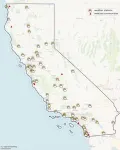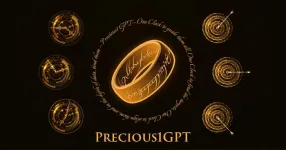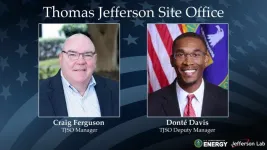(Press-News.org) Key Takeaways
Banned since 1968, the legacy of redlining persists: There continue to be instances of discrimination affecting people in these historically redlined areas.
Redlining was associated with lower odds of hitting screening targets for all three types of cancer: 24% lower odds in breast cancer, 64% lower odds in colorectal, and 79% lower odds in cervical cancer, compared with non-redlined areas.
Actionable initiatives to improve cancer screening rates: Questionnaires to determine barriers to cancer screening, mobile cancer screening efforts, and alternative screening tests, can help address these inequities.
CHICAGO (June 15, 2023): Although redlining was outlawed more than 50 years ago, new research shows that people today who live in historically redlined areas are less likely to be screened for breast, colorectal, and cervical cancer than people who live in areas not associated with redlining practices.
Redlining is a discriminatory practice in which financial institutions refuse to provide loans or insurance to people who live in an area deemed to be a poor financial risk. The practice predominately impacted Black home buyers, contributing to segregation and inequality. Congress banned the practice under the Fair Housing Act of 1968, but people who live in the areas that were once redlined continue to be negatively affected, as evidenced by low rates of cancer screening, according to a study recently published in the Journal of the American College of Surgeons. Until this study, the impact of historical redlining on cancer screening, regardless of contemporary social vulnerability, has been largely unexplored.
“Our study shows that the legacy of redlining has a long historical arc that still persists today due to chronic under investment in these areas,” said the study’s lead author Timothy Pawlik, MD, PhD, MPH, MTS, MBA, FACS, FRACS (Hon), a surgical oncologist who is the surgeon-in-chief of The Ohio State University Wexner Medical Center. “Redlining serves as a surrogate for systemic racism, especially as it pertains to those who live in areas that lack adequate investment in education, employment, transportation, and healthcare.”
An example of how redlining persists is the case of a national real estate company that was sued for discrimination by fair housing groups for its policy of not offering real estate services to owners selling homes under a minimum price level, Dr. Pawlik said. In 2022, the company, Redfin, agreed to a $4 million settlement and to expand its services for lower-priced houses.
Key study findings
Using national 2020 census-tract level data on cancer screening rates and historical redlining grades, the researchers found that:
Among 11,831 census-tracts, 3,712 tracts were redlined, with the greatest number of redlined tracts in New York and California, particularly in the New York City and Los Angeles metropolitan areas.
Redlining was associated with lower odds of hitting screening targets in all three types of cancer: 24% lower odds in breast cancer, 64% lower odds in colorectal, and 79% lower odds in cervical cancer, compared with non-redlined areas. This association persisted even after adjusting for contemporary social vulnerability and access to care.
A large proportion of the total effect of redlining on cancer screening was attributable to poverty, lack of education, and limited English proficiency.
“I find this study on the impact of historic redlining practices on current cancer screening rates to be incredibly important and sobering. The findings clearly demonstrate that the legacy of redlining continues to contribute to significant disparities in breast, colorectal, and cervical cancer screening, highlighting the urgent need for targeted interventions and policy reforms to address underlying structural racism and improve health equity in our historically marginalized communities,” said David Tom Cooke, MD, FACS, professor and chief of the Division of General Thoracic Surgery at UC Davis Health, and president of the Thoracic Surgery Directors Association.
Dr. Cooke, who was not involved with the study, added, “This study underscores the responsibility of healthcare systems, including academic and non-academic medical centers, to proactively tackle social determinants of health, such as redlining, to achieve equitable access to cancer screening and ultimately save lives.”
How to alleviate the impact of redlining on cancer screening rates
By demonstrating the long-term implications of discriminatory practices, the study results can help shape healthcare and social policy reform to reduce health inequities, Dr. Pawlik said.
Those efforts start with specific, actionable initiatives, Dr. Pawlik said. To determine how to improve cancer screening rates in specific areas may require resident questionnaires to determine the potential barriers, he said. For example, if transportation was a barrier, travel vouchers could be provided; or if English proficiency was a barrier, an interpreter could be provided.
Among the approaches that could help improve cancer screening rates in historically redlined areas include:
Government policies that target the areas with social services aimed at poverty alleviation, affordable housing, and education.
Initiatives to improve access to preventive cancer care may mitigate cancer screening disparities. One example is the Mobile Mammography Van by the Navajo Breast and Cervical Cancer Prevention Program.
Alternative methods to make it easier for affected people to get screened. For example, since colonoscopies pose significant barriers, such as bowel prep and devoting most of the day for the exam, tests to detect DNA mutations and blood in the stool may be a more workable approach, Dr. Pawlik said.
“I think the fact that the cancer screening is so disparate in these communities is a real wake up call to all of us,” Dr. Pawlik said.
Study coauthors are Zorays Moazzam, MD; Selamawit Woldesenbet, MS, MPH, PhD; Yutaka Endo, MD, PhD; Laura Alaimo, MD; Henrique A. Lima, MD; Jordan Cloyd, MD, FACS; Mary E. Dillhoff, MD, FACS; and Aslam Ejaz, MD, FACS.
Disclosures: Nothing to disclose.
Citation: Moazzam Z, Woldesenbet S, Endo Y, et al. Association of Historical Redlining and Present-Day Social Vulnerability with Cancer Screening. Journal of the American College of Surgeons. DOI: 10.1097/XCS.0000000000000779.
# # #
About the American College of Surgeons
The American College of Surgeons is a scientific and educational organization of surgeons that was founded in 1913 to raise the standards of surgical practice and improve the quality of care for all surgical patients. The College is dedicated to the ethical and competent practice of surgery. Its achievements have significantly influenced the course of scientific surgery in America and have established it as an important advocate for all surgical patients. The College has more than 87,000 members and is the largest organization of surgeons in the world. “FACS” designates that a surgeon is a Fellow of the American College of Surgeons.
END
Historic redlining practices cast a long shadow on cancer screening rates
A new study shows that people who live in historically redlined areas have lower screening rates for breast cancer, cervical cancer, and colorectal cancer
2023-06-15
ELSE PRESS RELEASES FROM THIS DATE:
Midgut gland of scallops: a valuable source of fucosylated heparan sulfate
2023-06-15
Glycosaminoglycans (GAGs), including chondroitin sulfate (CS), heparan sulfate (HS), heparin, and hyaluronan are linear and acidic polysaccharides found in the extracellular matrix of all animal tissues. GAGs are widely used as functional ingredients in health products, pharmaceuticals, and cosmetics, and are prepared from biological samples such as shark cartilage and porcine intestinal mucosa. Consequently, the demand for new sources of GAGs is ever-present. For example, the supply source of the anticoagulant heparin—generally prepared from porcine intestinal mucosa in China—was threatened by African swine fever in 2018.
GAGs derived from marine invertebrates—animals ...
University of Cincinnati research finds potential therapy for rare but devastating lung disease
2023-06-15
A treatment for a rare cancer-like lung disease found in women of childbearing age may have been discovered by University of Cincinnati researchers.
The rare lung disease is called lymphangioleiomyomatosis or LAM, and the cause of it is unknown with no cure established. New UC research, funded by the National Heart, Lung, and Blood Institute, discovered that two existing drugs show signs of being effective in treating LAM and could lead to the development of a cure.
The study was published in Science Advances,
“The exact number of women with LAM is unknown but it is estimated that for every 1 million women in the world, three to seven ...
Insilico Medicine’s transformer-based aging clock provides insights into aging, disease, and new therapeutic targets
2023-06-15
Clinical stage generative artificial intelligence (AI)-driven drug discovery company Insilico Medicine (“Insilico”) has announced a new multimodal transformer-based aging clock that is capable of processing diverse data sets and providing insights into biomarkers for aging, mapping them to genes relevant to both aging and disease, and discovering new therapeutic targets designed to slow or reverse both aging and aging-related diseases. The company calls the aging clock Precious1GPT, in a nod to the powerful “One Ring” in Lord of the Rings. The findings were published in the June 13 issue of the journal Aging.
Insilico has been ...
Hip fracture burden to nearly double worldwide by 2050
2023-06-15
An international group of researchers led by the Department of Pharmacology and Pharmacy, LKS Faculty of Medicine, the University of Hong Kong (HKUMed), and including Douglas P Kiel, MD, MPH, Director Musculoskeletal Research Center, Marcus Institute for Aging Research, Hebrew SeniorLife, and Professor of Medicine, Harvard Medical School, evaluated the secular trends in hip fracture incidence, treatment patterns following a hip fracture, and all-cause mortality in 19 countries and regions from 2005 to 2018. While the age- and sex-standardised hip fracture incidence rates decreased ...
Research findings „Study on Adult Learning and Education“
2023-06-15
From August 2022 until October 2022, interviews with 25 experts from the selected countries were conducted and then analyzed trough a Ground Theory approach. From this, a model emerged, showing how factors and actors at different societal levels - mega, macro, meso and micro - interact to shape adult learning and education in different contexts.
Mega level comparisons show that overarching issues such as war and conflict, historical and systemic discrimination, disease and extreme poverty as well as political authoritarianism act both as an impetus and as barriers to ALE activities.
Comparative analysis shows that at the macro level, with ...
New tool uncovers COVID-19 susceptibility mechanism
2023-06-15
Researchers have discovered a mechanism for COVID-19 susceptibility using a newly created tool. The tool, GASPACHO, captures dynamic changes in gene expression along the innate immune response, allowing researchers to identify genes and molecular pathways associated with disease risk that have previously been too complex to detect or interpret.
Using GASPACHO (GAuSsian Processes for Association mapping leveraging Cell HeterOgeneity), researchers at the Wellcome Sanger Institute, the National Center for Child Health and Development in Japan, Tel Aviv University and their collaborators have identified a gene variant that affects COVID-19 susceptibility. ...
Jefferson Lab oversight roles filled by DOE
2023-06-15
NEWPORT NEWS, VA – The U.S. Department of Energy has selected Craig Ferguson to lead the Thomas Jefferson Site Office (TJSO) at the Thomas Jefferson National Accelerator Facility in Newport News, Va. As TJSO manager, Ferguson will lead in the oversight and contract management of Jefferson Lab. Additionally, Donté Davis has been confirmed as TJSO deputy manager, a role he first stepped into earlier this year.
Ferguson is familiar with Jefferson Lab and its mission, having already served in a leadership role at the lab. In 2005-2008, he was the lab’s associate director for environment, safety, health & quality.
“I am excited to return ...
High-quality child care contributes to later success in science, math
2023-06-15
Children who receive high-quality child care as babies, toddlers and preschoolers do better in science, technology, engineering and math through high school, and that link is stronger among children from low-income backgrounds, according to research published by the American Psychological Association.
“Our results suggest that caregiving quality in early childhood can build a strong foundation for a trajectory of STEM success,” said study author Andres S. Bustamante, PhD, of the University of California Irvine. “Investing in quality child care and early childhood education could help ...
Study finds that a small number of teachers effectively double the racial gaps among students referred for disciplinary action
2023-06-15
Washington, June 15, 2023—The top 5 percent of teachers most likely to refer students to the principal’s office for disciplinary action do so at such an outsized rate that they effectively double the racial gaps in such referrals, according to new research released today. These gaps are mainly driven by higher numbers of office discipline referrals (ODRs) issued for Black and Hispanic students, compared to White students. The study, published in Educational Researcher, a peer-reviewed journal of the American Educational Research ...
Previously overlooked algae toxin widespread in southern Indian River Lagoon
2023-06-15
Spanning about one-third of Florida’s East coast, the Indian River Lagoon has faced frequent harmful algal blooms in recent years. Among them, Pseudo-nitzschia spp., algae that produces the neurotoxin domoic acid.
Domoic acid can bioaccumulate within food webs, causing sickness and death in higher trophic level organisms such as marine mammals and birds, and have been documented in sea turtles in Florida coastal waters and in bull sharks within the Indian River Lagoon system. In humans, consumption of shellfish contaminated with domoic acid can cause harmful symptoms.
Unlike other harmful algal blooms, Pseudo-nitzschia are not bioluminescent and do not cause water discoloration ...
LAST 30 PRESS RELEASES:
Tracing the quick synthesis of an industrially important catalyst
New software sheds light on cancer’s hidden genetic networks
UT Health San Antonio awarded $3 million in CPRIT grants to bolster cancer research and prevention efforts in South Texas
Third symposium spotlights global challenge of new contaminants in China’s fight against pollution
From straw to soil harmony: International team reveals how biochar supercharges carbon-smart farming
Myeloma: How AI is redrawing the map of cancer care
Manhattan E. Charurat, Ph.D., MHS invested as the Homer and Martha Gudelsky Distinguished Professor in Medicine at the University of Maryland School of Medicine
Insilico Medicine’s Pharma.AI Q4 Winter Launch Recap: Revolutionizing drug discovery with cutting-edge AI innovations, accelerating the path to pharmaceutical superintelligence
Nanoplastics have diet-dependent impacts on digestive system health
Brain neuron death occurs throughout life and increases with age, a natural human protein drug may halt neuron death in Alzheimer’s disease
SPIE and CLP announce the recipients of the 2025 Advanced Photonics Young Innovator Award
Lessons from the Caldor Fire’s Christmas Valley ‘Miracle’
Ant societies rose by trading individual protection for collective power
Research reveals how ancient viral DNA shapes early embryonic development
A molecular gatekeeper that controls protein synthesis
New ‘cloaking device’ concept to shield sensitive tech from magnetic fields
Researchers show impact of mountain building and climate change on alpine biodiversity
Study models the transition from Neanderthals to modern humans in Europe
University of Phoenix College of Doctoral Studies releases white paper on AI-driven skilling to reduce burnout and restore worker autonomy
AIs fail at the game of visual “telephone”
The levers for a sustainable food system
Potential changes in US homelessness by ending federal support for housing first programs
Vulnerability of large language models to prompt injection when providing medical advice
Researchers develop new system for high-energy-density, long-life, multi-electron transfer bromine-based flow batteries
Ending federal support for housing first programs could increase U.S. homelessness by 5% in one year, new JAMA study finds
New research uncovers molecular ‘safety switch’ shielding cancers from immune attack
Bacteria resisting viral infection can still sink carbon to ocean floor
Younger biological age may increase depression risk in older women during COVID-19
Bharat Innovates 2026 National Basecamp Showcases India’s Most Promising Deep-Tech Ventures
Here’s what determines whether your income level rises or falls
[Press-News.org] Historic redlining practices cast a long shadow on cancer screening ratesA new study shows that people who live in historically redlined areas have lower screening rates for breast cancer, cervical cancer, and colorectal cancer






